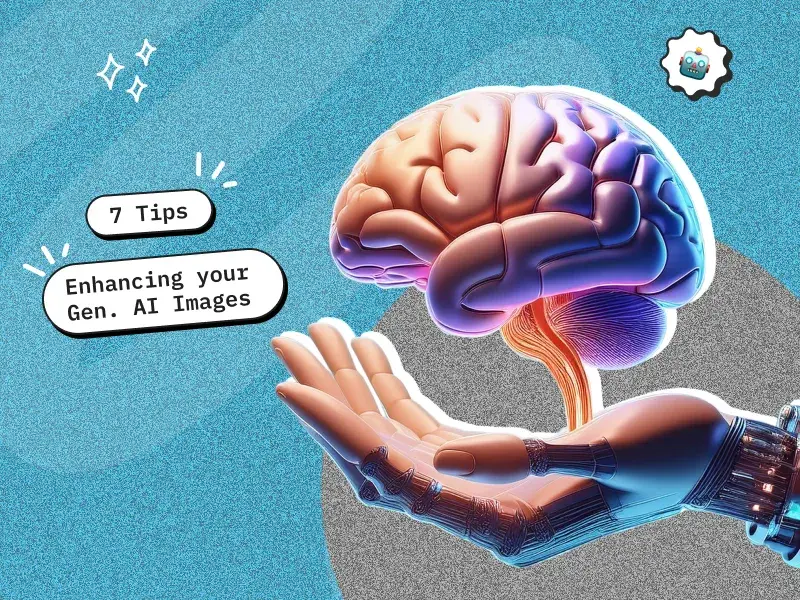Generative AI has transformed creative industries by enabling the generation of highly detailed and imaginative visuals. However, producing consistently high-quality images requires more than just powerful algorithms—it demands thoughtful execution and strategic planning. Here are eight essential tips to help you achieve exceptional results with generative AI.
Incorporating generative AI solutions into your workflow can streamline the process, offering tailored approaches to optimize image generation. Whether it's selecting the right model, curating datasets, or implementing advanced techniques, these solutions ensure your AI-driven visuals meet high-quality standards consistently.
By following these strategies, businesses and creatives can maximize the potential of AI-driven image generation, ensuring top-tier outputs across various applications.
How Are Generative AI Images Created?
Generative AI creates images by training models on large datasets, learning patterns and features to recreate or generate new visuals. Techniques like GANs and VAEs are widely used for this purpose. GANs consist of two neural networks: a generator that creates images and a discriminator that evaluates them for authenticity. VAEs, on the other hand, encode and decode images from a compressed latent space, allowing for the generation of new images by sampling from this learned space. These methods enable the creation of new visuals that are both realistic and imaginative.

Understanding how generative AI works, including its core techniques, is essential to grasp its wide range of applications across industries such as marketing, entertainment, and design.
Strategies to enhance Generative AI images
1. Select the Right Generative AI Model
Choosing the right model is the foundation of generating high-quality AI images. Different models like DALL-E, MidJourney, and Stable Diffusion are designed for specific outputs. For example, DALL-E excels in intricate and creative compositions, while Stable Diffusion is known for its ability to generate realistic and consistent images. Selecting a model that aligns with your creative objectives is key, and working with a generative AI development company can help ensure you choose the best model to meet your unique needs.
2. Use Diverse and Relevant Datasets
A model’s performance is directly tied to the data it learns from. To ensure high-quality image generation, you need a large, diverse dataset that’s relevant to your target output. Clean and curate the dataset to eliminate low-quality or irrelevant data. A well-curated dataset allows the AI to capture various patterns, ensuring it can produce accurate and detailed images.
3. Implement Data Augmentation Techniques
Data augmentation is an effective way to expand your dataset and make your model more robust. Techniques like flipping, rotating, and color adjustments artificially increase dataset diversity, helping the model generalize better. This reduces the risk of overfitting to specific data points and results in more versatile image outputs.
4. Regularize the Training Process
Regularization techniques like dropout, weight decay, and batch normalization help prevent overfitting and improve the model’s ability to generalize. These methods ensure that your AI model doesn’t become too specialized in the training data, leading to higher-quality and more adaptable image generation.
5. Test the Model Across Scenarios
To ensure the generative AI model performs well in a variety of contexts, it’s essential to test it across different scenarios. Evaluating the model’s output in diverse environments allows you to identify potential biases or weaknesses. Regular testing helps you fine-tune the model for optimal performance and higher-quality image generation.
6. Keep Learning and Adapting
The field of generative AI is evolving rapidly, with new models, algorithms, and best practices constantly emerging. Staying up-to-date with the latest advancements in AI will help you refine your techniques. Engage with AI communities, attend conferences, and stay informed through research publications to keep your models at the forefront of innovation.
7. Understand the Limitations of AI
Despite the impressive capabilities of generative AI, it’s essential to recognize its limitations. AI can sometimes produce unexpected or inaccurate results, especially in complex or ambiguous situations. Knowing when to rely on human expertise for final quality checks can significantly improve the reliability and overall quality of your AI-generated images.
8. Partner with a Generative AI Development Company
If you’re looking to consistently produce high-quality AI-generated visuals, partnering with a generative AI development company can be a valuable asset. Experts in the field can guide you through the complexities of model selection, dataset curation, and advanced techniques, ensuring you achieve top-tier results.
Conclusion
Achieving high-quality generative AI images involves more than just running a model. By selecting the right AI tools, curating robust datasets, implementing techniques like data augmentation, and staying updated with advancements, you can elevate your AI-generated images to new heights. While AI is a powerful tool, integrating human oversight ensures that your creative vision remains aligned with your business objectives.
Source URL: https://www.creolestudios.com/enhance-generative-ai-images-tips/



No comments:
Post a Comment